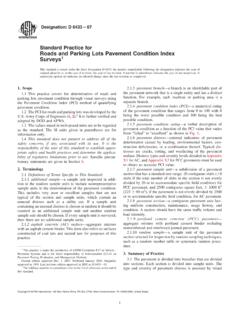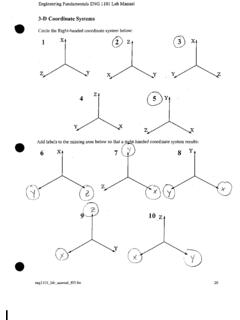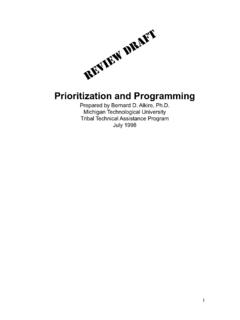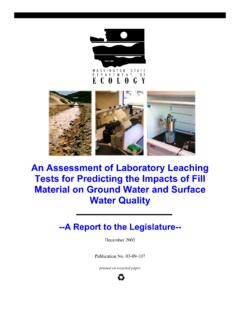Transcription of Best Practices Handbook on Asphalt Pavement Maintenance
1 -.., .. *'..* .. ;'..* .. , ' 0' ., ', .. '.;,. , -- technical report Documentation PageI I. report No. l2 3 kcipientus Accession No I 4 I itle and Subtitk I3ES'I I'RAC'lICES Handbook ON Asphalt Pavement Maintenance 7 Aiitlior(s) M. Johnson, -9. I'ctfotming Organization Namc and Address Professional Fngineering Services, L,td. 2 I3 'K'ownes Lane Wayzata, Minnesota 55391 12. Sponsoring Organization Name and Address llnivcrsity of Minnesota Center for Transportation Studies 200 Transportation & Safety Bldg. 5 1 1 Washington Avenue, Minneapolis, Minnesota _I_ -IS.
2 Supplementary Notes _I 16. Ahstract (lmtit: 200 words)I-I___ 5. report Date February 2000 8. l'erfotming Organization report No. 10. l'rojeet/7ask/Work IJnit No I I. ('ontract (C') or Grant (G) No 13 I ype of report and Period Covered 14 Sponsoring Agency ('ode __--The purpose of this Handbook is to provide background information about the importance of Pavement preservation and preventive Maintenance , as well as present Maintenance techniques for a variety of distresses and conditions. The major focus of this Handbook is on preventative Maintenance activities, which are performed while the roadway is still in good condition with only minimal distress, before the pavemeni falls into a condition where structural overlays, major milling or reclaiming, or replacement is necessary.))
3 'The most common flexible Pavement distresses are cracking, roughness, weathering, raveling, rutting and bleeding. If the distresses identified in a Pavement are related to structural deficiencies, the Pavement section is most likely not a candidate for preventive Maintenance treatment, and should be scheduled for rehabilitation or reconstruction. Maintenance treatments covered in this Handbook include: Crack repair wisealing, including clean and seal, saw and seal, and rout and seal; crack filling, full depth crack repair, fog seal, seal coat, double chip seal, slurry seal, microsurfacing, thin hot mix overlays, and potholes and Pavement patching.
4 'I'ables are outlined giving the most common flexible Pavement distresses, along with the best Practices for rehabilitation for each. Also given are recommended applications for crack sealers and fillers, surface treatments, and pothole patching. Specifications, technical memoranda and special provisions are included for all treatment methods recommended in the 18. Availability Statement1 7 1)ocurnenl Analysisi1)escriptots -7-- Asphalt Pavement Maintenance Fog seal Seal coat No restrictions. Document available from: Preventive Maintenance Pothole:; National technical Information Services, Crack sealing Microsurfacing 1 soI9 Security ('lass (this report ) I 20 Security ('lass (this page) I 2 I.
5 No. of Pages 1 22. Price IJnclassified linclassified Best Practices Handbook on Asphalt Pavement Maintenance February 2000 PUBLISHED BY Minnesota Technology Transfer (T2) Center / LTAI Program Center for Transportation Studies University of Minnesota 5 1 1 Washington Avenue Minneapolis., MN 55455-0375 Prelpared by Ann Johnson, , Professional Engineering Services, Ltd. Edited by Pamela J. Snopl, Managing Editor, T2/CTS PRINTEDBY Minnesota Department of Transportation Office of Researclh and Strategic Services 395 John Ireland Blvd.
6 St. Paul, MN 55155 Phone: 65 1-282-2274 E-mail: The University of Minnesota is an equal opportunity educator and employer. This publication is available in alternative formats upon request. Printed with 30 prrcent postconsumer waste. Acknswledgments; We wish to thank the Minnesota Local Road Research Board (LRRB) for the financial support to make this important resource possible. The technical Advisory Panel that steered this project was extremely helpful in identifying key issues and concerns of those responsible for maintaining our Asphalt pavements.
7 They also were very gcnerous with their time to review this document and contribute to its technical accuracy and application within Minnesota. We appreciate the assistance of the following people who served on the technical Advisory Panel for this resource document: Gary Bergeson, Minnesota Department of Transportation Gary Bruggeman, Minnesota Department of 'Transportation Maria Hagen, Univeirsity of Minnesota, Center for Transportation Studies Jerry Geib, Minnesota Department of Transportation Paul Keranen, Minnesota Department of Transportation Steve Lund, Minnesota Department of Transportation Mike Marti, Koch Pavement Solutions Roger Olson, Minnesota Department of Transportation Kevin Pieper, Hennepin County Duane Schwartz, City of Roseville Doug Weiszhaar.
8 Mnnnesota Department of Transportation Tom Wood, Minnesota Department of Transportation Project consultation provided by Ann Johnson, Professional Engineering Services, Ltd. Contents Part I: Pavement Maintenance and 1 Chapter 1: Types of Maintenance .. 1 Preventive Maintenance and Pavement Preservation .. 4 Corrective Maintenance .. 7 Emcrgency Maintenance .. 8 Chapter 2: A Systems Approach to Pavement .9 Pavement Management Systcms .. 9 Mn/DOT's Pavement Maintenance Program .. 10 Traffic Control and Safety .. 11 Chapter 3: Treatment 13 Determining a Treatment's Cost-Effectiveness.
9 1 3 Selection Factors .. 14 Types of Maintenance Treatments .. 15 Part IJ: Recommended Treatment Practices .. 21 Chapter 4: Crack Treatments ..3 Crack Repair with Sealing: Clean and 26 Crack Repair with Sealing: Saw and 28 Crack Kepair with Sealing: Rout and Seal .. 30 Crack Filling .. 32 Full-and Partial-Depth Crack Repair .. 3 4 Chapter 5: Surface Treatments .. 37 Fog Seal .. J8 Seal 40 Double Chip Seal .. 43 Slurry Seal .. 45 Microsurfacing .. 47 Thin Hot-Mix Overlays .. 49 Chapter 6: Pothole Patching and ] .jl Cold-Mix Asphalt .
10 54 Spray Injection 55 Hot-Mix Asphalt .. 57 Patching with Slurry or Microsurfacing Material ..!j 8 Bibliography .. Appendix A: Distress Identification and ~ ..~ ..63 Bleeding .. 64 Cracking, Alligator or Fatigue .. 64 Cracking, Block .. 64 Cracking, Edge .. 65 Cracking, Longitudinal .. 65 Cracking at Joints, Reflection .. 65 .. Cracking, I ransverse .. 66 Lane-To-Shoulder Drop-Off .. 66 Patch/Patch Deterioration .. 66 Polished 67 Potholes .. 67 Kaveling and Weathering .. 67 67 68 Appendix B: Mn/DOT Specifications and Provisions.








